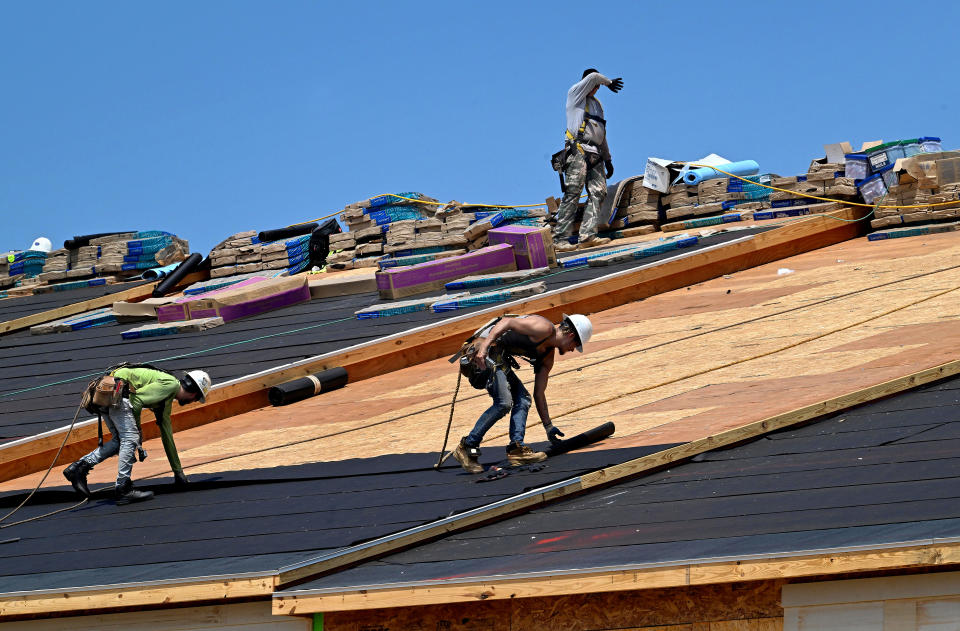The D.C. region needs to build 87 new homes per day. It’s not close.
- Oops!Something went wrong.Please try again later.
Corrects graf beginning "D.C., Prince George’s County ... " to add that Montgomery County has also adopted the housing targets; originally moved April 10, 2024
- - -
In 2019, a group of D.C.-area elected leaders said the region needed to build at least 320,000 housing units in the next decade to accommodate the region’s growth. But more than a third of the way through the decade, the region is falling behind the pace needed to meet this target, a Washington Post analysis found.
In the face of a worsening housing shortage, the Metropolitan Washington Council of Governments (COG), made up of regional lawmakers, drew up the housing target, which would require the addition of more than 87 units per day.
But from 2020 to 2023, the region produced an average of about 60 units per day, already creating a deficit of more than 40,000 units, according to data The Post analyzed from the Housing Association of Nonprofit Developers (HAND), a local affordable housing advocacy group, and the Urban Institute, a public policy think tank.
Housing production isn’t distributed evenly around the region. The Post determined each jurisdiction’s share of the regional housing target based on anticipated household growth this decade, and found D.C., Arlington County, Falls Church and Alexandria are on track to exceed their share of the targets. But the other nine jurisdictions represented by COG are all lagging. Fairfax County, the most populous jurisdiction in the region, is on pace to build only 36 percent of its target.
D.C., Prince George’s County, Montgomery County and the City of Alexandria have adopted COG’s targets in their own housing policies, though Montgomery County Executive Marc Elrich (D) has criticized them and said they don’t accurately capture the region’s housing demands. In statements to The Post, housing officials in Loudoun County and Prince William County also expressed support.
Several county leaders blamed the shortfalls on the pandemic’s effect on the economy. “The current economic environment with higher interest rates has been challenging for developers,” said Russell Danao-Schroeder, a principal planner for Arlington County.
“And labor? There was no labor,” added Hilary Chapman, COG’s housing program manager. Construction industry snarls over the past decade have resulted in an annual shortage of more than 700,000 construction workers nationwide, according to a report from the Home Builders Institute.
The available data captures a particularly difficult time, said Aspasia Xypolia, the director of Prince George’s County’s Department of Housing and Community Development. Now out of the pandemic, the county may be able to build more housing, she said. The Federal Reserve has hinted at moderately lower interest rates this year, which could open more financing options for developers.
COG based its targets on the region’s anticipated growth. Using similar metrics, the Urban Institute established its own regional housing production goals, estimating a need for about 250,000 units from 2020 to 2030. Even with that lower target, only Arlington County, Alexandria and D.C. are on track to meet their goals, though Frederick and Loudoun counties aren’t far off. The Urban Institute recommended that half of new housing should be affordable to households earning roughly 80 percent of the region’s median income - amounting to no more than about $2,300 in monthly housing costs - and no jurisdiction is even at 20 percent, a Post analysis found.
Elrich thinks COG’s targets are based on faulty assumptions. “This language that ‘we need this’ is being used to create a sense of panic that all these people are coming here and we don’t have any housing,” said Elrich, who was a member of COG in 2018, before it adopted the housing targets. “And it’s based on falsely portraying that the number of people they say are coming here represents what you need to build or what you need to zone for.” The county is drawing high earners amid a life-science industry boom, he noted, adding, “There’s not a chance in hell I would incentivize low-wage jobs to come to Montgomery County.”
Montgomery County requires developers to set aside 15 percent of the units in new projects for low-income households, Elrich pointed out. The HAND-Urban Institute data shows the county has satisfied this requirement. But the county is on track to produce just over half the number of homes recommended by COG.
Some jurisdictions where housing affordability is a relatively new problem are playing catch-up. Loudoun County didn’t create its Department of Housing and Community Development until two years ago, said John Hall, the agency’s director. “For an agency that is only two years old, we are doing a pretty good job,” he said. Loudoun is nearly on pace to meet the COG housing production target, the data shows.
Colleen Green, the director of D.C.’s Department of Housing and Community Development, said the city has made housing production a priority in recent years. But Mayor Muriel E. Bowser’s (D) proposal to slash D.C.’s Housing Production Trust Fund by at least 40 percent will make it even harder to create enough affordable housing, Green acknowledged. “It will hurt,” she said. If the cuts take effect, “you’ll probably see a dip in some upcoming years.”
The housing shortage falls hardest on low earners and people of color, said Courtney Battle, the executive director at HAND. More than 610,000 renter households in the region spend at least 30 percent of their income on rent and utilities, according to a recent study by the Joint Center for Housing Studies at Harvard University. As a result, the region’s most vulnerable lose out on opportunities to build wealth and face high rates of housing instability, Battle said.
“How do we produce more housing?” Chapman said. “Everyone’s trying to crack that.”
The jurisdictions that are on pace to meet their targets lie in the region’s urban core. In those that aren’t, many neighborhoods are not zoned for dense housing development and have historical protections that block new development, said Leah Hendey, a principal research associate at the Urban Institute. “There is just a lot of land where greater density is not allowed,” she said.
Last year, the region issued permits for 20,509 new housing units. For most jurisdictions, the number of permitted units was lower than in 2022.
There is no guarantee all those units will be built; projects can get stuck behind regulatory barriers. And even if the current rate of permitting continues, it won’t be enough to meet the Council’s target, a Post analysis found.
The pandemic’s upheaval has left vacant commercial real estate in its wake, but that doesn’t mean the need for affordable housing has declined, Chapman said. “Rents are going up,” she said. “Housing prices are going up. The level of affordability is going down. The problem is getting worse, not better.”
It can take years for local governments to approve zoning and design, and these delays can account for 40 percent of a housing development’s budget, according to a study by the National Association of Home Builders. Opposition by not-in-my-backyard groups can also hold up building and drain a developer’s wallet.
Proposed legislation in the District, Maryland and Virginia could remove some of the red tape for housing development, like zoning reviews that can cause years of bureaucratic delays. Local and federal lawmakers are also looking at additional ways to subsidize affordable housing development and to repurpose vacant offices and underused church land for housing. Legislation in the Senate would expand the low-income housing tax credit, which makes affordable housing costs more feasible for developers.
But, Chapman said, “there’s no one thing that’s going to solve the problem.”
- - -
Graphics:
https://washingtonpost.com/documents/e8102ad8-0f06-4c75-878f-506f0f49d3b6.pdf
https://washingtonpost.com/documents/66718332-130c-4017-a31f-6dddf2a74dc7.pdf
https://washingtonpost.com/documents/6b4dc424-0aad-41a8-868a-666c7f4470d9.pdf
Related Content
The horse wars of Stormy Daniels
Alone in a bathroom: The fear and uncertainty of a post-Roe medication abortion
How Donald Trump’s mug shot became a defiant and divisive 2024 symbol


